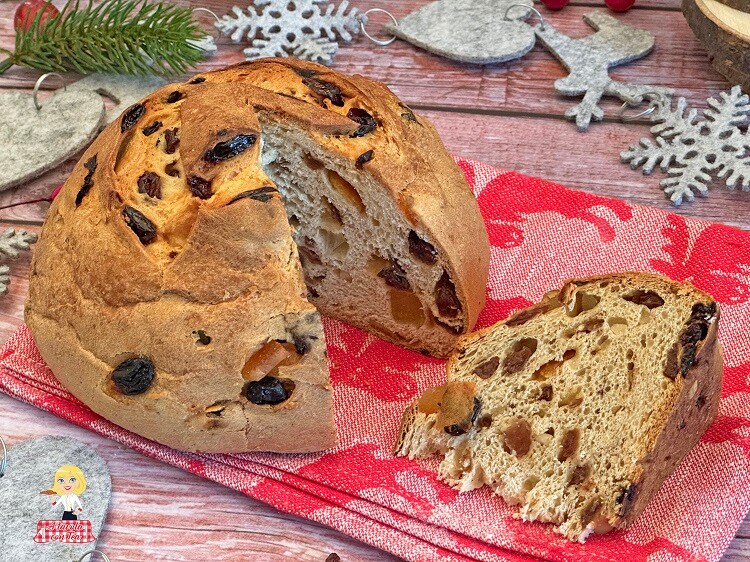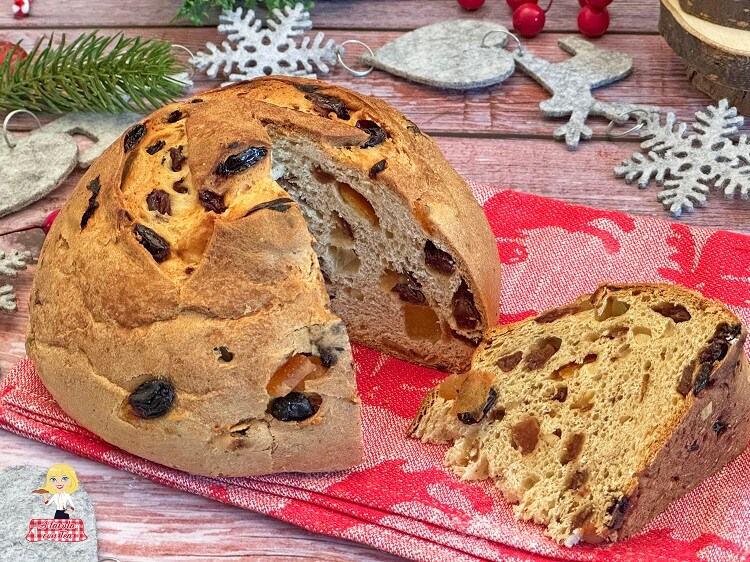TRADITIONAL HIGH GENOVESE PANDOLCE YEASTED the Panettone of GENOA original recipe passed down through generations
In all homes at Christmas comes the inevitable question: team PANDORO or team PANETTONE?
At our house, the answer is simple and immediate, neither one nor the other because for us, it’s not Christmas if there’s no PANDOLCE. Yes, because if you’re Ligurian, there’s no escaping it: Pandolce is the quintessential Christmas dessert loved by all, young and old alike, without which it’s not CHRISTMAS.
For those unfamiliar, there are two types of PANDOLCE GENOVESE: the Low Genovese Pandolce without yeast also called OLD GENOA, and the High Genovese Pandolce, commonly known as the Panettone of Genoa, which is yeasted.
Both are delicious, though I must confess my favorite is the LOW GENOVESE PANDOLCE, for me it’s almost a passion if not an obsession. Every year, I make hundreds not just for eating but also as sweet Christmas gifts for friends and family.
I’m such a fan of this Christmas dessert that last year I even participated in the First Low Genovese Pandolce Championship and with great joy, I placed second with my grandma Lisetta’s legendary recipe (If you want to try it, I’ll leave the link HERE.
But back to us, since many of you recently asked if I also had the recipe for the High Genovese Pandolce, the tall yeasted one, and I had never tried it, I decided to get to work for you. After various phone calls in search of the right recipe and several attempts, I found what I believe is the best recipe to prepare the Panettone of Genoa.
So I am very proud to present my traditional High Genovese Pandolce yeasted original recipe passed down through generations in the family of my best friend, and who knows, it might become my favorite from now on, who can say! If you are looking for other typical Christmas desserts, also see

- Difficulty: Medium
- Cost: Medium
- Rest time: 8 Hours
- Preparation time: 45 Minutes
- Portions: 10
- Cooking methods: Oven
- Cuisine: Italian
- Seasonality: New Year’s Eve, Christmas
- Energy 406.29 (Kcal)
- Carbohydrates 68.18 (g) of which sugars 36.25 (g)
- Proteins 7.05 (g)
- Fat 13.64 (g) of which saturated 5.80 (g)of which unsaturated 6.71 (g)
- Fibers 2.23 (g)
- Sodium 14.42 (mg)
Indicative values for a portion of 75 g processed in an automated way starting from the nutritional information available on the CREA* and FoodData Central** databases. It is not food and / or nutritional advice.
* CREATES Food and Nutrition Research Center: https://www.crea.gov.it/alimenti-e-nutrizione https://www.alimentinutrizione.it ** U.S. Department of Agriculture, Agricultural Research Service. FoodData Central, 2019. https://fdc.nal.usda.gov
Ingredients
- 1 1/4 cups Manitoba flour
- 1/3 cup water (lukewarm)
- 8 g fresh yeast (or about 3 g of dry yeast)
- 2 cups all-purpose flour
- 7/8 cup sugar
- 1/2 cup butter (softened)
- 1/3 cup water
- 8 g fresh yeast (or about 3 g of dry yeast)
- 1 cup raisins
- 3/4 cup candied fruit (orange and citron)
- 2/3 cup pine nuts
Tools
- Bowl
- Pan
Steps
Dissolve the yeast in a bowl with lukewarm water. Add the flour and mix with a spoon. Cover with plastic wrap and let it rise for about 8 hours at room temperature (it could take from 8 to 10 hours).
Dissolve the second dose of yeast in lukewarm water as well. Place the pre-ferment (BIGA) prepared earlier, which should be around 275 g, in a bowl or in the bowl of the mixer. Add the flour, sugar, and the second dose of dissolved yeast and start kneading.
As soon as the dough comes together, add the butter (it should be softened to room temperature, not melted) and continue kneading until the dough has completely absorbed it. It will take about 15 minutes (even 20). You’ll know it’s ready when it looks smooth and homogeneous and detaches from the sides of the bowl without effort.
At this point, you can add the raisins (make sure they are not soaked beforehand), the candied fruits (I use mixed orange and citron), and the pine nuts. Knead by hand (even if you used the mixer before) until they are evenly distributed in the dough.
Transfer the dough onto a lightly floured work surface and stretch it with your hands to form a rectangle. Fold it like a book by folding both ends of the rectangle towards the center. Flip it over with the folds underneath and place it in a pan lined with parchment paper. Let it rest covered with a cloth for about 4 hours or until it has doubled in volume.
Now that your High Genovese Pandolce has risen, make the traditional triangular cuts on the surface with a knife then bake in a preheated static oven at 340°F for about 1 hour. It should be golden and puffy, as with other leavened desserts, the toothpick test can help you check if it’s done. Once ready, remove it from the oven and let it cool completely. Merry Christmas!

NOTES
YEAST: I manage better with fresh yeast, but you can use dry yeast if you prefer. In this case, about 2.5-3 g is needed for the pre-ferment and the same amount for the main dough. Be careful when dissolving the yeast in water, it should be lukewarm not hot, otherwise, it will deactivate the yeast.
RAISINS: Normally, when adding raisins to sweet leavened doughs, they are rehydrated by soaking in water or liquor…not in this case. Make sure to use them directly from the package, otherwise, you will ruin all the work.
CANDIED FRUIT: Personally, I prefer to make a mix of orange and citron candied fruits but feel free to use any candied fruit you prefer as long as the total quantity remains the same. If they are not already diced when you buy them, I recommend cutting them into cubes as uniformly sized and small as possible.
AROMAS: In some recipes, the dough is flavored with orange blossom water (you only need 1 tablespoon) or with liquor. I chose not to include either.
STORAGE
Once ready, the High Genovese Pandolce keeps well in a tightly sealed food bag in a cool, dry place for up to a week.
CURIOSITIES
When was the Genovese pandolce born?
According to legend, in the 1500s, the Doge of the Republic of Genoa organized a contest among the city’s master pastry chefs to create a dessert that represented the wealth of Genoa, could be preserved for a long time, and was nutritious: thus, the GENOVESE PANDOLCE, also known as the PANETTONE of GENOA, was born.

